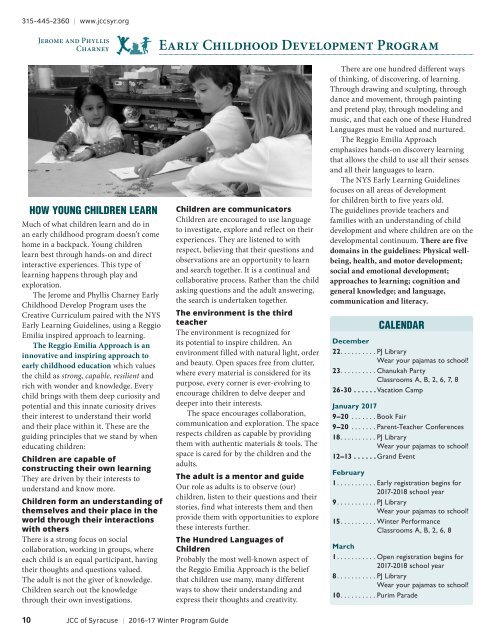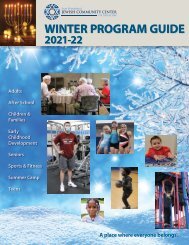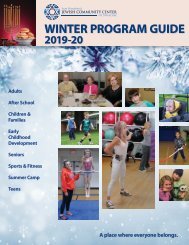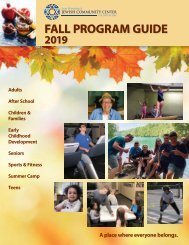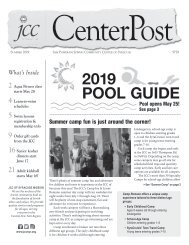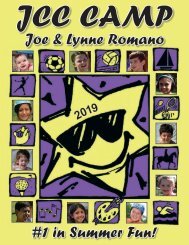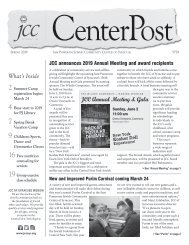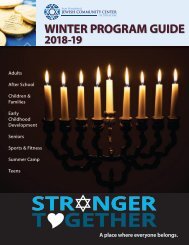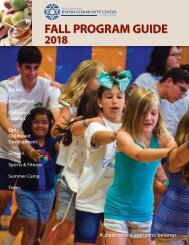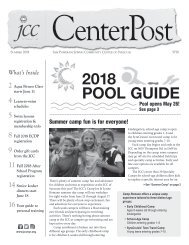2016-17 Winter Program Guide
JCC of Syracuse winter program guide and newsletter. Check out all of our programs/services and upcoming classes!
JCC of Syracuse winter program guide and newsletter. Check out all of our programs/services and upcoming classes!
Create successful ePaper yourself
Turn your PDF publications into a flip-book with our unique Google optimized e-Paper software.
315-445-2360 | www.jccsyr.org<br />
Jerome and Phyllis<br />
Charney<br />
Early Childhood Development <strong>Program</strong><br />
HOW YOUNG CHILDREN LEARN<br />
Much of what children learn and do in<br />
an early childhood program doesn’t come<br />
home in a backpack. Young children<br />
learn best through hands-on and direct<br />
interactive experiences. This type of<br />
learning happens through play and<br />
exploration.<br />
The Jerome and Phyllis Charney Early<br />
Childhood Develop <strong>Program</strong> uses the<br />
Creative Curriculum paired with the NYS<br />
Early Learning <strong>Guide</strong>lines, using a Reggio<br />
Emilia inspired approach to learning.<br />
The Reggio Emilia Approach is an<br />
innovative and inspiring approach to<br />
early childhood education which values<br />
the child as strong, capable, resilient and<br />
rich with wonder and knowledge. Every<br />
child brings with them deep curiosity and<br />
potential and this innate curiosity drives<br />
their interest to understand their world<br />
and their place within it. These are the<br />
guiding principles that we stand by when<br />
educating children:<br />
Children are capable of<br />
constructing their own learning<br />
They are driven by their interests to<br />
understand and know more.<br />
Children form an understanding of<br />
themselves and their place in the<br />
world through their interactions<br />
with others<br />
There is a strong focus on social<br />
collaboration, working in groups, where<br />
each child is an equal participant, having<br />
their thoughts and questions valued.<br />
The adult is not the giver of knowledge.<br />
Children search out the knowledge<br />
through their own investigations.<br />
Children are communicators<br />
Children are encouraged to use language<br />
to investigate, explore and reflect on their<br />
experiences. They are listened to with<br />
respect, believing that their questions and<br />
observations are an opportunity to learn<br />
and search together. It is a continual and<br />
collaborative process. Rather than the child<br />
asking questions and the adult answering,<br />
the search is undertaken together.<br />
The environment is the third<br />
teacher<br />
The environment is recognized for<br />
its potential to inspire children. An<br />
environment filled with natural light, order<br />
and beauty. Open spaces free from clutter,<br />
where every material is considered for its<br />
purpose, every corner is ever-evolving to<br />
encourage children to delve deeper and<br />
deeper into their interests.<br />
The space encourages collaboration,<br />
communication and exploration. The space<br />
respects children as capable by providing<br />
them with authentic materials & tools. The<br />
space is cared for by the children and the<br />
adults.<br />
The adult is a mentor and guide<br />
Our role as adults is to observe (our)<br />
children, listen to their questions and their<br />
stories, find what interests them and then<br />
provide them with opportunities to explore<br />
these interests further.<br />
The Hundred Languages of<br />
Children<br />
Probably the most well-known aspect of<br />
the Reggio Emilia Approach is the belief<br />
that children use many, many different<br />
ways to show their understanding and<br />
express their thoughts and creativity.<br />
There are one hundred different ways<br />
of thinking, of discovering, of learning.<br />
Through drawing and sculpting, through<br />
dance and movement, through painting<br />
and pretend play, through modeling and<br />
music, and that each one of these Hundred<br />
Languages must be valued and nurtured.<br />
The Reggio Emilia Approach<br />
emphasizes hands-on discovery learning<br />
that allows the child to use all their senses<br />
and all their languages to learn.<br />
The NYS Early Learning <strong>Guide</strong>lines<br />
focuses on all areas of development<br />
for children birth to five years old.<br />
The guidelines provide teachers and<br />
families with an understanding of child<br />
development and where children are on the<br />
developmental continuum. There are five<br />
domains in the guidelines: Physical wellbeing,<br />
health, and motor development;<br />
social and emotional development;<br />
approaches to learning; cognition and<br />
general knowledge; and language,<br />
communication and literacy.<br />
CALENDAR<br />
December<br />
22 ..........PJ Library<br />
Wear your pajamas to school!<br />
23 ..........Chanukah Party<br />
Classrooms A, B, 2, 6, 7, 8<br />
26-30 ......Vacation Camp<br />
January 20<strong>17</strong><br />
9–20 .......Book Fair<br />
9–20 .......Parent-Teacher Conferences<br />
18 ..........PJ Library<br />
Wear your pajamas to school!<br />
12–13 ......Grand Event<br />
February<br />
1 ...........Early registration begins for<br />
20<strong>17</strong>-2018 school year<br />
9 ...........PJ Library<br />
Wear your pajamas to school!<br />
15 ..........<strong>Winter</strong> Performance<br />
Classrooms A, B, 2, 6, 8<br />
March<br />
1 ...........Open registration begins for<br />
20<strong>17</strong>-2018 school year<br />
8 ...........PJ Library<br />
Wear your pajamas to school!<br />
10 ..........Purim Parade<br />
10 JCC of Syracuse | <strong>2016</strong>-<strong>17</strong> <strong>Winter</strong> <strong>Program</strong> <strong>Guide</strong>


